| 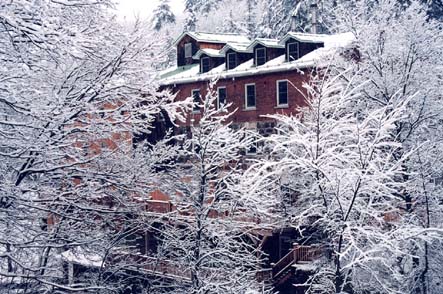
Photo courtesy Le Moulin Inn & Spa
Mon
pays ce n'est pas un pays c'est l'hiver
Mon Pays begins with
a statement of belief that illustrates the universality of the relationship
with the wintry land which is deeply felt in Québec.
My country is not a country,
it is winter.
My garden is not a garden, it is the plain.
My road is not a road, it is snow.
My country is not a country, it is winter.
To people of both English and
French backgrounds, this song speaks to a profound part of the national
psyche. For Canadians from Atlantic to Pacific are internationally
renowned for their long, cold winters, and for their almost unique
ability to embrace them with resignation, if not actual delight.
But for the people of Québec,
winter and the many possibilities for enjoyment that it offers represent
an occasion for enthusiastic anticipation and eager participation
throughout the province from the moment the first snow falls to
the ground.
An Outaouais winter
This is particularly the case in l’Outaouais,
the part of Québec that sits right across from Ottawa and
includes the National Capital Region, Gatineau Park, and the charming
towns of Chelsea and Wakefield. It has many attractions to appeal
to visitors in every season of the year, but winter is an especially
pleasant time to spend here.
The range of activities, both outdoor and
indoor, is perhaps unmatched in any other area of the province.
It is possible to travel from the urban centre of Ottawa, with its
many historic sites, museums, and fine restaurants, into the wilds
of Gatineau Park within half an hour by car on the easily accessible
highway linking the capital to this magnificent nature preserve.
I recently spent a pleasant time exploring
this up-and-coming region of Québec as a guest of the local
tourist board, visiting for a short time in the fall and for a more
lengthy stay in January. Both times I was struck by the sheer variety
of attractions l’Outaouais has to offer, from cross-country
skiing to elegant dining, and from outdoor adventures to some of
the Canada’s most important museums and art galleries, not
to mention a world-class casino.
Getaway Outaouais
The winter season came late to eastern Canada
in 2007, and there was barely any snow on the ground when I boarded
the VIA Rail train at Toronto’s Union Station, on an early
January day, en route to Ottawa, the first stop on my Outaouais
adventure. Shortly after leaving the city, however, I was happy
to see the snow-covered fields glistening in the sun, and by the
time I arrived in Ottawa the clouds had moved in and it was snowing.
This was certainly a far more familiar winter scene welcoming me
than the one I had left behind in tropical Toronto!
The temperature had dropped considerably,
and I was glad that an already warmed-up Chrysler mini-cruiser was
waiting for me at the station, courtesy of the local tourist bureau.
As I left the national capital, and drove across the bridge spanning
the majestic Ottawa River, I caught a glimpse of the National Art
Gallery and the Museum of Civilization on either side of the river,
which separates the provinces of Ontario and Québec. After
dropping my guide off at the regional tourist office, I proceeded
north into Gatineau Park, ready for my first experience of a Canadian
winter so far this year. I was actually eager to catch up for the
winter activities I had so far missed in this current season.
A First Nations name
L’Outaouais is the Algonquin First
Nations word for the Ottawa River, and is used to refer to one of
Québec’s many tourist regions. Not as well known as
Montréal, Québec City, the Laurentians, or the Gaspé,
l’Outaouais has been eager to establish a position for itself
on the province’s tourist radar screen in recent years, by
highlighting some of its many appealing attractions, and in particular
their close proximity to each other.
Within minutes of leaving Ottawa and arriving
in Québec, I found myself taking the highway exit for the
lovely village of Chelsea, where I was to have lunch at a small
local eatery known as Café Soup’Herbe.
The name of this vegetarian establishment
is actually a French play on words, involving “soup,”
“herbs,” and “superb.” My lunch, a delicious
croissant sandwich of cheese, onions, and roasted red peppers, accompanied
by a fresh green salad, certainly lived up to the café’s
name billing. I was the only anglophone person in the restaurant,
and I enjoyed listening to my French-speaking fellow diners engaged
in friendly conversation over their lunch.
Bilingual Outaouais
Since my teens, I have travelled to various
parts of Québec many times, and have witnessed the dramatic
changes that have transformed its society beginning in the tumultuous
years of the “Quiet Revolution” of the 1960s. This was
the period when French-Canadians began to assert themselves in Québec
itself and on the national scene as a whole. In the half century
since then, the relationship between Québécois and
their fellow English-speaking citizenry has certainly had its ups
and downs, including two independence votes, the last one only narrowly
defeated in 1995. But for me, on every occasion when I visit Québec
I am always pleasantly reminded of my country’s bilingual,
bicultural nature, something that is easy to forget when one lives
in a multilingual city such as Toronto, where French is not as common
as some of the other languages that comprise Canada’s multicultural
reality.
In l’Outaouais, and Ottawa as well,
bilingualism is a fact of life. It is truly a border zone between
what High MacLennan the a famous Canadian novelist once called the
nation’s “two solitudes” of French and English,
where both are in close proximity to each other, and communicate
easily across the linguistic divide.
My guide José Lafleur, for example,
a charming young francophone woman and an Outaouais native, could
switch easily from French to English in conversations with me and
her colleagues. This is the case with many residents of the area,
on both sides of the border. There are sadly only a very few parts
of Canada where the national policy of official bilingualism appears
to be practised on an everyday level. I have had the pleasure of
visiting two of them, the province of New Brunswick and l’Outaouais.
I often wonder what it would take to plant this wonderful aspect
of the country’s cultural mosaic in other parts of Canada,
and reflect on how it would lead to greater mutual understanding
and appreciation among those who inhabit each of the “two
solitudes.”
The Outaouais sense
of adventure
But these musings were quickly dispelled
by what awaited me on my second stop that afternoon. This was Laflèche
Adventure, a huge outdoor activity centre that boasts the largest
natural caves in the Canadian Shield and North America’s longest
aerial park. The facility remains open year round, but attracts
most of its visitors during the summer months. Then they can soar
above the lake on a zip trek line, challenge themselves with an
obstacle course involving tarzan ropes, nets, and wooden trapeze-style
steps hanging from the trees, and hike nature paths through the
mountain slopes. Having exhausted their outdoor activities (and
possibly themselves as well!), visitors can literally go underground,
and explore the fascinating caves that water pressure has carved
out of the rock face over the millennia.
On the day I arrived, I was met by my guide
for the afternoon, Marc-André Dorval. Marc’s passion
is caves, and he is a well-known spelunker, or cave explorer. But
before we descended into the caverns, he urged me to at least attempt
one of the obstacle courses that remain open during the winter.
He showed me how to attach my harness to the zip line and encouraged
me to follow him in a dramatic swoop across the frozen lake, suspended
in space about 50 feet above ground. Unfortunately, I was recovering
from some recent eye surgery, and didn’t feel as bold as I
might usually have done. Instead, I was content to watch him disappear
along the zip line, only to resurface on the other side of the lake,
perched above a high wooden platform, waving at me. I did attempt
one obstacle course, climbing up to the top of the same platform
and stepping carefully along a series of wooden slats from tree
to tree. But the icy conditions of the course that day dissuaded
me from any further outdoor aerial adventures, and I was happy when
Marc suggested we proceed to our exploration of the caves.
Equipped with a miner’s hard hat with
a battery-powered light and a pair of high rubber boots, I was ready
to make the descent. While the caves are impressive at any time
of the year, perhaps they are at their most stunning in winter,
when icy stalactites and stalagmites appear to grow like mysterious
flowers from the cave ceiling and floor. For the first time I mastered
the difference between these two terms, which had frequently confused
me in the past. As Marc informed me, the French words tomber
(to fall) and monter (to rise) can serve as a useful aide-mémoire,
if one remembers that stalactites (with a T) descend from the top
of a cave, while stalagmites (with an M) rise from the ground.
We spent a few minutes in total darkness,
as Marc and I turned off our helmet lanterns to experience the complete
blackness of the cave. He told me that groups of young people sometimes
like to spend overnight trips in the caves, their sleep at times
disturbed by the flapping of the wings of the thousands of bats
inhabiting them.
|
Winter
Adventures in Québec's l’Outaouais
by Peter Flaherty 
The legendary
Québec poet and chansonnier Gilles Vigneault is best
known for his song Mon Pays. This evocative hymn to Québec
culture has become the unofficial anthem of Canada’s predominantly
French-speaking province, which Canada's federal Parliament recently
recognized as “a nation within Canada.”
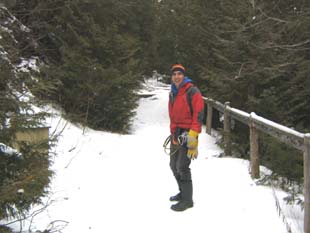
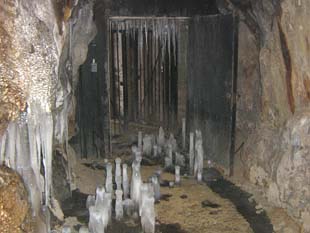
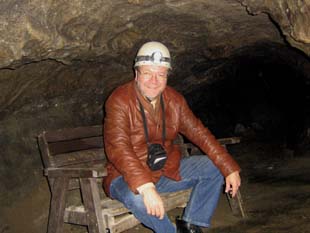
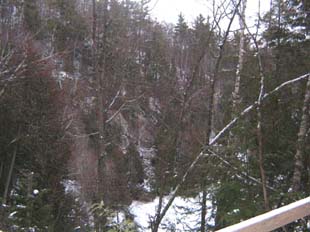
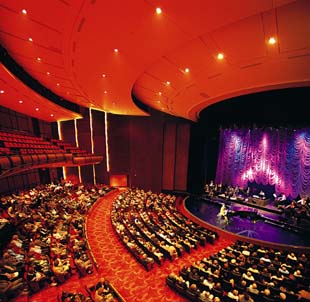
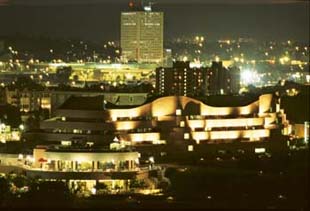
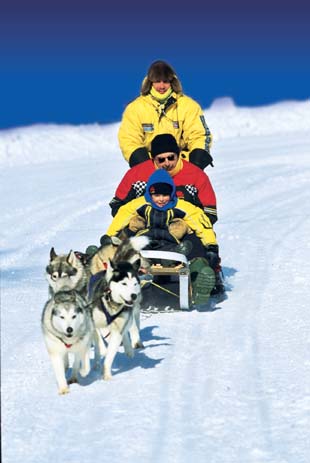
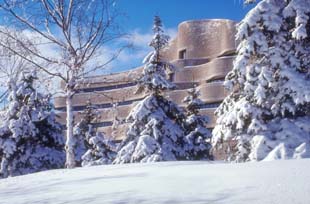
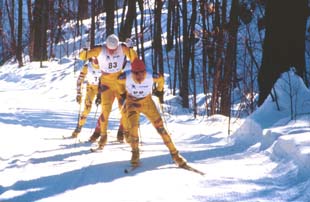
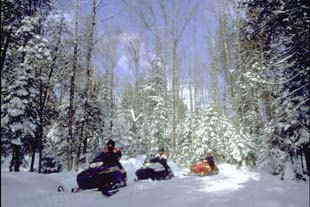
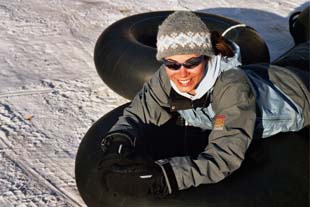
Last seven photos courtesy Tourisme
Outaouais
Outaouais Resources
Gilles
Vigneault's song Mon Pays
Tourism
Outaouais
Gatineau
Park
The
City of Gatineau
The
City of Ottawa
Chelsea
The
National Art Gallery of Canada
The
Museum of Civilization
The
War Museum of Canada
Laflèche
Adventure
Le
Moulin Inn & Spa / The Wakefield Inn
Le Nordik
Spa en Nature
L'Orée
du Bois
Le
Tartuffe
Guide
Debeur
VIA
Rail
|
We spent a few minutes in total darkness,
as Marc and I turned off our helmet lanterns to experience the complete
blackness of the cave. He told me that groups of young people sometimes
like to spend overnight trips in the caves, their sleep at times
disturbed by the flapping of the wings of the thousands of bats
inhabiting them.
For now, however, these nocturnal creatures
were all deep in their winter hibernation, their bodies suspended
on the cave walls, some of them completely encrusted with frost.
These bats are of many varieties, some of them with considerable
wingspans. I was not sure how I would have responded to them if
I were to spend a night inside these dark, narrow caverns.
Marc’s tour was extremely informative,
and he pointed out some of the recent explorations that experienced
spelunkers had been making, seeking to trace some of the tunnels
to their sources. He told me that many of these passages remained
unexplored, and that quite possibly the network of caves running
underground could be much more extensive than the considerable part
that had already been excavated.
Upon returning to the surface, I took a few
minutes to visit the gift shop, where some very attractive pieces
of jewelry made from polished stones were on sale. Marc talked with
me about the year-round operations of Laflèche Adventures,
and particularly of the young people who descend on the facility
every summer to find jobs as guides and facilitators.
An Outaouais inn
Somewhat tired from my explorations with
Marc, I was glad to return to my car and drive through the snow-covered
mountains into the lakeside town of Wakefield, one of the loveliest
spots in l’Outaouais.
My destination was Le Moulin, or the Wakefield
Mill Inn and Spa, the town’s premier lodging establishment
and my home for the next two pleasant nights. The inn is a lovingly
restored 1838 heritage stone mill, and my room faced the waterfall
that once powered the mill wheels for a grist, woolen, and saw mill.
Today it offers the visitor the comfort of 27 rooms, a fully-equipped
spa with outdoor jacuzzi, a charming bar with fireplace, and The
Penstock, a fine restaurant serving a variety of locally-influenced
dishes, based on French and Québécois cuisine. After
resting and taking in the stunning view from my window, I was ready
to enjoy a delicious diinner, accompanied by my host from the tourist
board.
From the elegant menu, we chose as our appetizer
a delicious pastry stuffed with goat cheese, accompanied by a sweet
fruit sauce. The main course was bison, raised on a nearby farm,
and cooked to perfection. Accompanying the meat was an excellent
red wine, which our waiter had carefully selected for us. Dessert
for me was the proverbial “no-brainer” when I visit
Québec. I am particularly partial to tarte au sucre,
a Québécois pie made with maple sugar and cream. I
have sampled this rich dessert many times in my travels across La
Belle Province, but I have to admit that the Penstock’s
version was one of the best I have ever tasted! Throughout our meal,
I enjoyed an animated conversation with Jose, switching from English
to French, over dessert, with my confidence in my linguistic abilities
perhaps fuelled by the glasses of wine I had sipped throughout dinner!
The next morning I awoke to a gray, rainy
scene outside, and wondered how the unpromising weather might affect
the winter activities in which I was expecting to participate that
day.
I had a delicious breakfast in the dining
room, joined by Robert Milling, the owner of the Mill, whose passion
for the building and its history was infectious. He described the
various incarnations of the property, from its days as the town’s
local mill through a disastrous fire that destroyed much of it early
in the 20th century to a period in which it remained practically
a ruin. The local tourist board planned to turn it into a working
museum of mill crafts, but the project soon proved to be beyond
its budget.
This is where Bob stepped in, with an ambitious
plan to restore the mill as an inn and spa. He showed me how local
stonemasons with 19th-century skills had to be be hired to reshape
the huge millstones on the first level, and how water damage from
an unexpectedly heavy spring run-off had almost sunk his project
in its early stages. But he was clearly proud of what he and his
wife had achieved, and was enjoying the fact that this property
was popular with individual visitors and corporate retreat groups
year-round.
A quiet Outaouais moment
After breakfast, Bob asked me if I was aware
of the fact that a famous Canadian Prime Minister, Lester B. Pearson,
was buried in the local cemetery perched on a hilltop above the
inn.I was vaguely aware of the fact,
but had never had the opportunity to visit the grave of this important
national figure.
Pearson had been the first Canadian to win
the prestigious Nobel Peace Prize for his efforts to dispatch UN
peacekeeping forces to the Middle East during the 1950s. Later,
as Prime Minister, his government had been influential in securing
the adoption of the red and white maple leaf flag as Canada’s
national emblem. Pearson died in 1972, and had asked to be buried
in Wakefield, in the middle of his beloved Gatineau Park. According
to Bob, one of Pearson’s sons still lives in the area.
The road from the inn to the cemetery was
difficult to travel on that day, because of the rain and slush,
but with Bob’s four-wheel drive vehicle we were quickly at
the top. As the mists covered the majestic hills, I stood at the
site of the grave of this major figure in Canada’s modern
history.
I reflected on the fact that unlike Americans,
who honour their former presidents extensively, we as a nation are
almost forgetful of those who have played such an important role
in shaping our national destiny. The maple leaf flag fluttering
over Pearson’s grave was a moving and appropriate reminder
of one of the significant contributions he and his government had
made to fostering Canadians’ sense of themselves as a proud,
independent country during the 1960s.
Leaving the inn, I drove down Provincial
Route 5 to my next stop, the main Visitor Centre of Gatineau Park.
There I was to meet with François Leduc, an extremely knowledgeable
member of the park staff who escorted me on a personal guided tour
of its many points of interest. Unfortunately conditions for cross-country
skiing were less than ideal on that day, with the rain turning the
snow already on the ground into a wet, slushy consistency. Nonetheless,
a few die-hard skiers were out on the trails making the best of
the situation. François informed me that on a normal winter
day the park would be very crowded, and many of the trails would
have quite heavy traffic. Later in the winter a number of ski weekends
and competitions were planned, and he was confident that conditions
would improve. And he was right — winter came late but with
a vengeance across southern Ontario and Québec a month later,
with major snowfalls and cold temperatures creating ideal cross-country
skiing opportunities in the Gatineau and throughout l’Outaouais.
Ah Gatineau!
There are very few major urban areas in North
America as fortunate as Ottawa to have such a treasure-trove of
natural wilderness so close to them.
Gatineau Park covers 363 square kilometres
of land, and permits visitors to enjoy a wide range of year-round
outdoor activities, including cross-country skiing and snowshoeing
in the winter, hiking and camping in the summer, and observing the
many species of birds, animals, and plants that flourish in its
environs. The Gatineau Hills were carved out of the landscape when
the glaciers retreated at the end of the last ice age, over 10,000
years ago. About 5000 years later, the first native peoples arrived
to inhabit the area. Since then, explorers, fur traders, lumbermen,
colonists, and industrialists have all established themselves in
the region, taking advantage of its many opportunities for economic
advancement. Beginning in the early 20th century, the federal government
decided to create a park in the Gatineau, and in 1937 it acquired
the first 16,000 hectares of land, which has been continually expanded
since then.
One of the most famous historic sites on
the grounds of Gatineau Park is Moorside, once the summer home of
William Lyon Mackenzie King, who was prime minister of Canada during
the time of the Great Depression and World War II.
An eccentric, somewhat reclusive bachelor,
King loved the solitude of his home in the park, where he would
take long walks with his beloved dog Pat. Fascinated with ancient
Graeco-Roman ruins, King had a number of architectural specimens
brought to his home from European archeological sites, some delivered
across the Atlantic even during World War II! Inclined to mysticism
and believing it possible to commune with the spirits of the dead,
King loved to stroll the grounds of his estate at nightfall, absorbing
the aura of the ruins surrounding him.
When he died in 1950, he bequeathed his 231-hectare
estate to the Canadian people so that it would forever remain a
public park and nature sanctuary. In the early 1980s, the National
Capital Commission, the federal body responsible for administering
the area around Ottawa on both sides of the Ontario-Québec
border, restored the house and turned it into a museum. As a result,
it is now possible to obtain a first-hand look at how this mysterious
but important public figure in Canadian history conducted his private
life. There is a delightful café and teahouse on the site,
which is open from spring to fall.
Gatineau Park is home to over 1000 species
of plants and 50 types of trees. Approximately 230 bird species
have been observed there, including the pileated woodpecker, which
can be seen in winter. Fifteen of these species are on Québec
or national endangered species lists, including the loggerhead shrike
and the cerulean warbler. Fifty-four species of mammals make the
park their home, 14 of which are at risk in Québec or the
rest of Canada, including the timber wolf. About 2000 white-tailed
deer reside in the park, and there are also 2000 beavers and a few
black bears. The day I visited, François led me on a short
nature walk through the forest near the Visitor Centre, where we
saw a beaver busily at work building a dam on the river, and also
a woodpecker drilling into a tree.
We then went on a short drive through the
park, and François pointed out some of the major points of
interest. These included Camp Fortune, the only downhill ski facility
in the area, and Meech Lake, a popular summertime beach made famous
to Canadians for the abortive constitutional accord negotiated at
the federal government’s conference centre located there.
For enthusiasts of cross-country skiing,
Gatineau Park is a wonderland in winter. The park boasts almost
200 kilometres of trails, track set for classic skiing, of which
100 kilometres are also groomed for skate skiing. In addition, the
parkways, which are used as roads during the summer months, are
also converted into ski trails in winter.
The additional 30 kilometres of roads offer
spectacular scenery and excellent ski conditions for skiers of all
levels of proficiency, from beginners to experts. As someone who
enjoys cross-country skiing, I was somewhat disappointed that the
weather had not cooperated better in order for me to hit the trails
that day. But after seeing just how superb the facilities are in
Gatineau Park, I made a mental note to myself to return as soon
as possible to enjoy them.
An Outaouais spa
While my morning in the park may not have
been quite as strenuous as I had originally hoped, my lack of exertion
did not restrain me from taking full advantage of my next stop,
a luxurious new spa quite close to the park entrance called Le Nordik.
This brand-new facility attracts both local
residents and visitors to the area alike for its unique outdoor
ambience. Set on a wooded hillside, many of the attractions are
outside, including hot, cold, and temperate baths, and a waterfall
that descends right into one of the large jacuzzis. Inside it is
possible to enjoy a variety of massages, including Swedish, Californian,
Thai, and hot stone therapy. When I arrived, there were many people
making bookings for treatments, especially groups of women who were
there for manicures, pedicures, and other forms of female beautification.
Marketing and sales coordinator Kim Morrisette greeted me and gave
me an extensive tour of the spa before we sat down for lunch duirng
which I learned about the ambitious plans of the spa’s owners
to expand the facility. After lunch, she suggested I try the steam
bath and take the plunge into the cold pool right afterward!
A couple of turns in the hot steam room followed
by an extremely invigorating splash of cold water from one of the
waterfalls led me to the hot tub, where I relaxed in the open, marvelling
at the mildness of the outdoor temperature. After this I followed
the path to the large jacuzzi and the newly-designed waterfall,
landscaped right into the hillside. The hot streams of water that
descended on my body as I stood under the cascade created an extremely
pleasant sensation.
After this I entered the salon de détente,
or relaxation area, where I had planned to sit facing a picture
window, admiring the view, while reading the book I had brought
with me. Pouring myself a cup of warm herbal tea, I opened the book,
settled comfortably into my easy chair, and within a minute was
fast asleep! About a half-hour later I awoke feeling totally relaxed,
only to remember that it was time for my massage appointment. Will
this relaxation ever end, I wondered.
I entered the massage room and was greeted
by Marie-Claude, a pleasant young woman who was studying to become
a registered massage therapist. Her technique was very professional
and excellent, as she worked over whatever tense spots were left
in my neck and back after my pleasant afternoon at the spa.
After my session with Marie-Claude, I went
to the café, still clad in my cozy terrycloth bathrobe, and
enjoyed a glass of port while I contemplated just how completely
at ease I was feeling.
As the darkness settled in, I decided to
take one more plunge into the hot tub, where the lights and the
steam rising from the water created a mystical atmosphere.
A woodland restaurant
Leaving Le Nordik with some reluctance, I
was happy to know that dinner was awaiting me not far away, at l’Orée
du Bois one of the finest restaurants in the area.
Owned and operated since 1978 by the husband
and wife team of Guy and Manon Blain, this lovingly restored old
farmhouse set in the forest offers the visitor a wonderful selection
of French and Québécois cuisine. L’Orée
du Bois is a restaurant with close ties to the terroir,
or local area, and only serves dishes made from fresh produce purchased
from neighbourhood farms.
For example, Manon proudly showed me the
garden where the fresh herbs and vegetables are grown, and the smokehouse
where fish, poultry, and meat are smoked over a bed of sweet-smelling
maple sawdust. They even make their own chocolate on the premises!
The assistant chef, Jean-Claude Chartrand, is a graduate of a prestigious
French culinary institute, and has used his wine expertise to help
stock the restaurant’s cellar with a selection of fine vintages.
I started with a pâté de
fois gras fondant, the creamiest, richest pâté
I have ever tasted. As I savoured every mouthful, I sipped a cold
locally-produced apple cider, a wonderful drink to pair with this
hors d’oeuvre. This was followed by potage St. Germain,
a take on traditional French-Canadian pea soup that was truly filling
and delicious, especially when accompanied by home-made bread. As
a main course, I selected a confit de canard, a perfectly
cooked duck in a delightful sauce. I selected a fine Australian
Shiraz as my wine of choice that evening, and I was not disappointed.
Manon visited me frequently during the course
of my meal to find out if I was enjoying myself, even though the
restaurant was quite busy. She need not have worried in the slightest;
it was one of the finest meals I have ever eaten, anywhere! Still
finding room for dessert, I selected a terrine au chocolat,
a trio of different home-made chocolate creams which was much more
interesting than the usual mousse au chocolat found in many French
restaurants.
After sipping an excellent espresso, I was
invited to go into the kitchen, to give my compliments to the chef.
Guy was busy doing all the things chefs do in the kitchen —
tasting dishes, taking orders, and generally creating some sense
of order out of what appeared to me to be a scene of complete, if
creative chaos. But he was able to find a few minutes to talk with
me about my meal, and share some reminiscences of how he and Manon
had built their business over the years.
I later discovered that Guy and Manon had
been awarded the National Capital Commission’s Epicurean Award
of Excellence, a very prestigious culinary prize. The Guide Debeur,
the Québec equivalent of the Michelin guides, also recognizes
it as a four-star establishment. In my opinion, these acknowledgments
are completely deserved. L’Oree du Bois is one of those rare
establishments that combines food and service of superb quality
with a homey, unpretentious atmosphere that makes the visitor feel
quite comfortable, or chez nous (among us) as the Québecois
like to say.
Feeling lucky
I was feeling quite fortunate after my wonderful
meal at l’Orée du Bois, and since it was too early
to return to the inn, I decided to try my luck at the Casino du
Lac-Lamy, a modern gaming temple on the outskirts of Gatineau, a
short drive from Chelsea.
The building was glittering in the night,
and I hoped that lady luck might be beckoning me as I parked the
car and entered the huge hall. There are over 1800 slot machines
and 64 gaming tables at Lac-Lamy, along with a Keno room, Bingo,
and electronic horseracing. The casino boasts a fine restaurant,
Le Baccara.
In the Théâtre du Casino, a
state-of-the-art performance space, a number of famous performers
present a variety of different types of musical entertainment year-round.
Lac-Lamy is not just about gambling, and it can be a truly multi-faceted
experience for the visitor. However, on that particular evening
I was only interested in seeing if I could make the machines work
in my favour. Unfortunately, it was not to be, and a few dollars
poorer than when I entered the casino, I departed, reflecting on
the old truism, “the house always wins in the end.”
L'Outaouais is a mindful
experience
The Museum of Civilization
The final day of my Outaouais adventure was
spent in two of the area’s most renowned museums, the Museum
of Civilization in Gatineau and the newly opened War Museum across
the river in Ottawa itself . I had visited the Museum of Civilization
on my earlier trip to the area in the fall, when I toured the magnificent
Petra-Lost City of Stone exhibit, presenting the wonders of the
world-famous archaeological site of Petra in Jordan. I had had the
good fortune of being invited to Jordan in late summer 2006, and
had spent three memorable days at this incredible site, and my visit
to the Museum of Civilization’s exhibit was a delightful refresher
course in the wonders of Petra.
Some 2000 years ago, a mysterious Middle
Eastern people, the Nabataeans, carved out a city from the red stone
walls of a forbidding desert canyon in southern Jordan. For centuries,
Petra flourished as a major trading centre on the route from Arabia
to the Mediterranean, and the business-minded Nabataeans enriched
themselves from the traffic of desert caravans stopping there. The
city had an innovative system for supplying water, an amazing feat
considering the fact that Petra was built in the middle of a desert.
After the decline of the trade routes, Petra was abandoned and remained
a ghost city of legend for centuries until European archaeologists
rediscovered it in the 19th century. Today, it is one of the most
important sites in the Middle East, receiving large numbers of visitors
annually. It was made famous by the recent film Indiana Jones
and the Last Crusade, in which the façade of the Treasury,
Petra’s most famous building, is prominently featured.
The Petra exhibition at the Museum of Civilization
included more than 170 artifacts on loan from museums in Jordan,
Europe, and the United States, and was jointly organized by the
Cincinnati Art Museum and the American Museum of Natural History
in New York. It presented a fascinating portrayal of Petra and the
people who once lived in it, including stone sculptures and reliefs,
a wide variety of ceramic pieces, metalwork, inscriptions, and 19th-century
paintings of the site. Three remarkable examples of Nabataean artistry
were the sculptured frieze from a temple, a capital sculpted in
the form of an elephant head, and a huge bust of the god Dushara.
Large projection screens presented images of some of the more grandiose
buildings that can be seen in Petra, giving the visitor a virtual
experience of what the site is actually like. At some moments, I
actually had the uncanny feeling that I was back in Petra again.
On my second visit to the museum in January,
I returned to tour a recently opened exhibition entitled “Masters
of the Plains: Ancient Nomads of Russia and Canada.” My guide,
Elena Ponomarenko, originally from Russia, provided me with an extremely
informative guided tour of this exhibit, which highlights the striking
similarities in the ways of life of indigenous peoples of Canada
and the steppes of Siberia.
The First Nations peoples of the Canadian
prairies were bison hunters, while their Siberian counterparts were
livestock herders, but each group adapted to its very similar grassland
environment in remarkably parallel ways. The Canadian Museum of
Civilization and the Samara Regional Museum in Russia collaborated
in mounting this exhibition, which presented over 400 artifacts
drawn from both cultures. They illustrated various themes in the
lives of these two nomadic plains peoples, including food preparation,
sacred rituals and beliefs, forms of artistic expression, trade,
home designs and living space, means of transportation, and warfare.
The exhibit also focussed on the condition of these peoples today,
as the pressures of modern civilization have impacted on their traditional
nomadic lifestyles. I was especially fascinated with the recreations
of nomadic encampments, including a Siberian yurt and a Plains Indian
tipi.
A culinary interlude
Following my visit to the Museum of Civilization
I met José for lunch in a pleasant little eatery with a 1960s
theme, appropriately called “Le Twist.” It is a “resto
bar” with a retro feel, operating out of an old restored house
on the rue Montcalm, right in the middle of downtown Gatineau. On
offer are such traditional favourites as hamburgers, fries, mussels,
and a variety of salads. Québec is famous for its frites,
or French fries, and Le Twist did not disappoint. The burger was
thick and juicy, and for dessert Jose tempted me, with very little
protest on my part, to sample yet another tarte au sucre de
maison as a sweet farewell to l’Outaouais. We also sampled
one of the local beers available on site, a tangy brew with a reddish
colour.
The city of Gatineau has many fine dining
establishments from which the visitor can choose. On my previous
visit, I had enjoyed a delicious dinner at le Tartuffe, an elegant
restaurant within easy walking distance of the Museum of Civilization.
That night I enjoyed a terrine of game accompanied by a cranberry
sauce for my appetizer. In keeping with the game theme, I ordered
a succulent filet of venison for my main course, and followed it
with a delicious crème brûlé for dessert.
Chef Gerard Fischer made me feel quite welcome in his establishment,
surrounded by a group of business-style diners, many of whom appeared
to be government officials in the requisite suits and evening wear.
The National War Museum
The War Museum was my last stop on a winter
tour of l’Outaouais that had included a rich and fascinating
variety of outdoor and indoor activities, and I was glad that I
had saved this venue for last.
I had been anticipating a visit to the new
War Museum ever since it reopened in 2005, but until this time had
been unable to fit it into my travel schedule. As a former History
teacher, this museum had special meaning for me. I had toured its
predecessor, once housed in a cramped building in downtown Ottawa.
But this new facility, five minutes by car from the centre of town,
is a moving and completely fitting memorial to the wars Canada has
fought and those who have fought in them, from colonial times to
the present.
The award-winning architect Raymond Morayama
designed the building, and its glass roof and angled walls give
it an unforgettable appearance as one approaches it. Every year
on November 11, the sun shines directly though a slit cut in the
side of one wall, illuminating the Hall of Remembrance, the focal
point of the museum. A series of self-guided exhibits traces Canada’s
military history, from the early conflicts between English, French,
and Native peoples for possession of North America, through the
two world wars, up to the postwar period when Canada made its greatest
contribution to international peacekeeping.
Besides its permanent displays the museum
hosts a number of major temporary exhibitions, most recently “Afghanistan:
A Glimpse of War,” profiling Canada’s military mission
to that country, a point of contention and some controversy among
Canadians today.
I spent the entire afternoon visiting the
various parts of the museum, enthralled with the fascinating exhibits
of military hardware, contemporary films, propaganda posters, uniforms,
and televised first-person accounts of battles and campaigns.
In one gigantic hall known as the LeBreton
Gallery there is a collection of tanks, planes, military vehicles,
and artillery from both world wars and the postwar era. At one point
I was stunned when I came upon a white UN peacekeeping jeep that
had been shot full of bullet holes. My guide told me that a group
of Canadian soldiers had narrowly escaped death in this very vehicle
when they had come under hostile fire while on patrol in Croatia
during the early 1990s. I instantly recalled that one of those soldiers
had been a former student of mine, and how after he recovered from
his injuries he had revisited my classes to speak to students about
his experiences in war-torn Yugoslavia.
It is at moments such as this that history
seems to leap out of the museum pieces that preserve it, to remind
one of its living presence and direct impact on our lives. This
awareness was brought home even more forcefully when I visited the
Royal Canadian Legion Hall of Honour, which displays the heroism
of Canadians who fought in the major conflicts in which this country
has participated, past and present.
The War Museum is more than just a place
that stores and presents military artifacts and memorabilia. It
is a lively place where discussions, film events, and other public
gatherings are hosted, often with major military and academic figures
in attendance. School groups are welcome, and I left wishing that
the museum had been completed while I was still teaching Canadian
history to my students. It would have made a wonderful field trip
to the national capital, where they might have obtained a privileged
look at the record of Canada’s fighting men and women throughout
history, something much more powerful than any textbook account
could provide.
Au revoir but
not adieu
It was after five o'clock in the afternoon,
and the War Museum was closing for the day as I waited for the taxi
to take me to the Ottawa VIA Rail Station for my return train trip
to Toronto.
I had spent a fascinating winter interlude
in l’Outaouais, enjoying a wide range of activities both indoors
and out, and came away with a sense of anticipation for all the
things I wanted to do there on my next visit. The official motto
of the tourist board says L’Outaouais — vivez-le!
(The Outaouais — Live it!).
I realize that I did exactly that.
|











